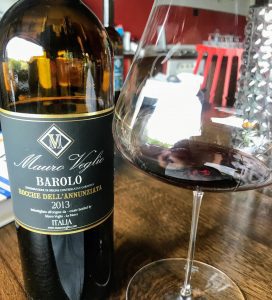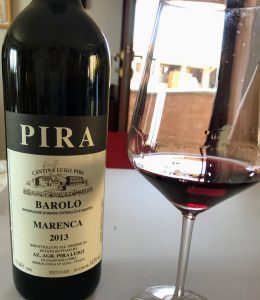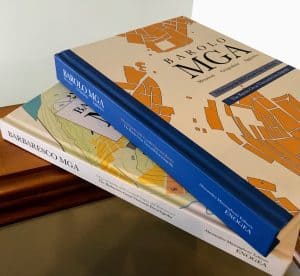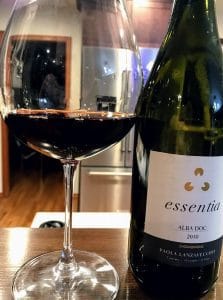
A section of the Grand Crus of Barolo map with the full version at http://www.jdemeven.cz/wine/Barolo_map.pdf
For centuries wine collectors and lovers have poured over maps of the top vineyard sites in Burgundy.
Names like Chambertin, Clos St Jacques, Les Amoureuses, La Tâche, Les Suchots, Les St Georges, Les Perrières, Charmes, Genevrières and Montrachet are practically tattooed on the hearts of wine geeks everywhere.
But as the prices of those wines reach several hundred and even $1000+ a bottle, it’s becoming more worthwhile to look outside of Burgundy for complex, terroir-driven wines.
One such area that is ripe for geeky exploration is Barolo and its sister region of Barbaresco.
Like Pinot noir, Nebbiolo does a fantastic job of conveying the story of where it came from–the soils, the micro-climate and the character of each vintage. Just like in Burgundy, a Barolo made in one cru could taste dramatically different than a Barolo made from vines that are just a stone’s throw away–even by the same producer and tended to in the exact same manner.
It’s clear that the next horizon for wine geekdom is going to be pouring over maps of the top vineyard sites in Piedmont and tattooing names like Rocche dell’Annunziata, Cannubi, Brunate, Vigna Rionda and others on our hearts. While prices of these wines are steadily starting to rise, good bottles showing amazing complexity and character can still be found for a fraction of the price of top Burgundy Grand and Premier Crus.

Really gorgeous Rocche dell’Annunziata from Mauro Veglio. This wine has the stuffing to last 20+ years.
That is one of the reasons why I was very excited to stumble upon this excellent map produced by a Czech blogger that highlights many of the top crus in Barolo. It’s well worth checking out and bookmarking.
The map offers a great description of the main soil types in Barolo–Tortonian and Helvetian–and the type of wines they tend to produce as well as general commune characteristics and the top crus from each.
A Few of My Favorite Barolo Crus
Last June I got an opportunity to visit Piedmont and fell in love with several wines from some of these top vineyards.

Only two producers work with the fruit of the Marenca cru in Serralunga d’Alba–Luigi Pira and Gaja for their Sperss Barolo.
Arborina (La Morra)
Gattera (La Morra)
Rocche dell’Annunziata (La Morra)
Sarmassa (Barolo)
Romirasco (Monforte d’Alba)
Margheria (Serralunga d’Alba)
Vigna Rionda (Serralunga d’Alba)
Marenca (Serralunga d’Alba)
Villero (Castiglione Falletto)
Other Great Resources For Geeking Out About Barolo and Barbaresco
Antonio Galloni’s Vinous site has some beautiful and very well put together interactive maps of Barolo and Barbaresco that are available to subscribers. These maps not only show the topography difference but also includes a quality ranking of Exceptional, Outstanding and Noteworthy. When you click on each vineyard the map give you a description for the style of the wines from the cru, key producer and reference bottles as well as links to educational videos that go into greater details about the terroir and wines.
Many of these write-ups are done by my Vino-Crush Ian D’Agata who is writing an upcoming book about Barolo and Barbaresco.
Barolo and Barbaresco: The King and Queen of Italian Wine by Kerin O’Keefe.
This goes a little more into history and the general culture of the region but also name drops important producers and vineyards.
Barolo and Barbaresco (Guides to Wines and Top Vineyards) by Benjamin Lewin.
Written by a Master of Wine, this is a fantastic (and super cheap) resource for anyone planning to visit the area because Lewin highlights the producers that have tasting appointments available.
Barolo MGA Vol. I & II and Barbaresco MGA by Alessandro Masnaghetti.

Masnaghetti’s books are written in both English and Italian.
These are really pricey (especially when you add international shipping) but they are, by far, the benchmark standard reference for intimately learning the cru vineyards of Barolo and Barbaresco. Beautifully illustrated with great detail, I picked up my copies while I was in Piedmont (at 40 euros apiece) and saved a little bit of money but they are well worth the publisher’s price and getting them shipped.
A Wine Atlas of the Langhe: The Great Barolo and Barbaresco Vineyards by Victtorio Mangnelli.
A little bit outdated (2003) but at around $53 it is cheaper than buying all of Masnaghetti’s volumes and is still a useful resource with detailed maps and producer listings.


